Displaying CLM Content in Veeva CRM on Desktop
- CRM Desktop (Mac, Windows)
To preview CLM presentation slides and prepare presentation windows to be shared in calls, users can display multiple presentations at once in Normal View, Slide Show View, Window View, and Presenter View. Users can prepare for calls by displaying presentations in Normal View and previewing presentations in Slide Show View, Window View, or Presenter View. Users can also easily switch between presentations while sharing content.
Users do not need an active internet connection to display presentations from Veeva CRM on Desktop. Any activity tracked offline automatically syncs when the user connects to the internet.
| View Name | Description |
|---|---|
| Normal View |
|
| Slide Show View |
|
| Window View |
|
| Presenter View |
|
Configuration is not needed for this feature.
Displaying Presentations in Normal View
When a user launches a presentation from the library, it displays in Normal View. The first slide is selected by default. Normal View only displays a preview of the selected slide. The slides are not interactive. In call mode, sharing a presentation in Normal View does not track the key messages on the call report.
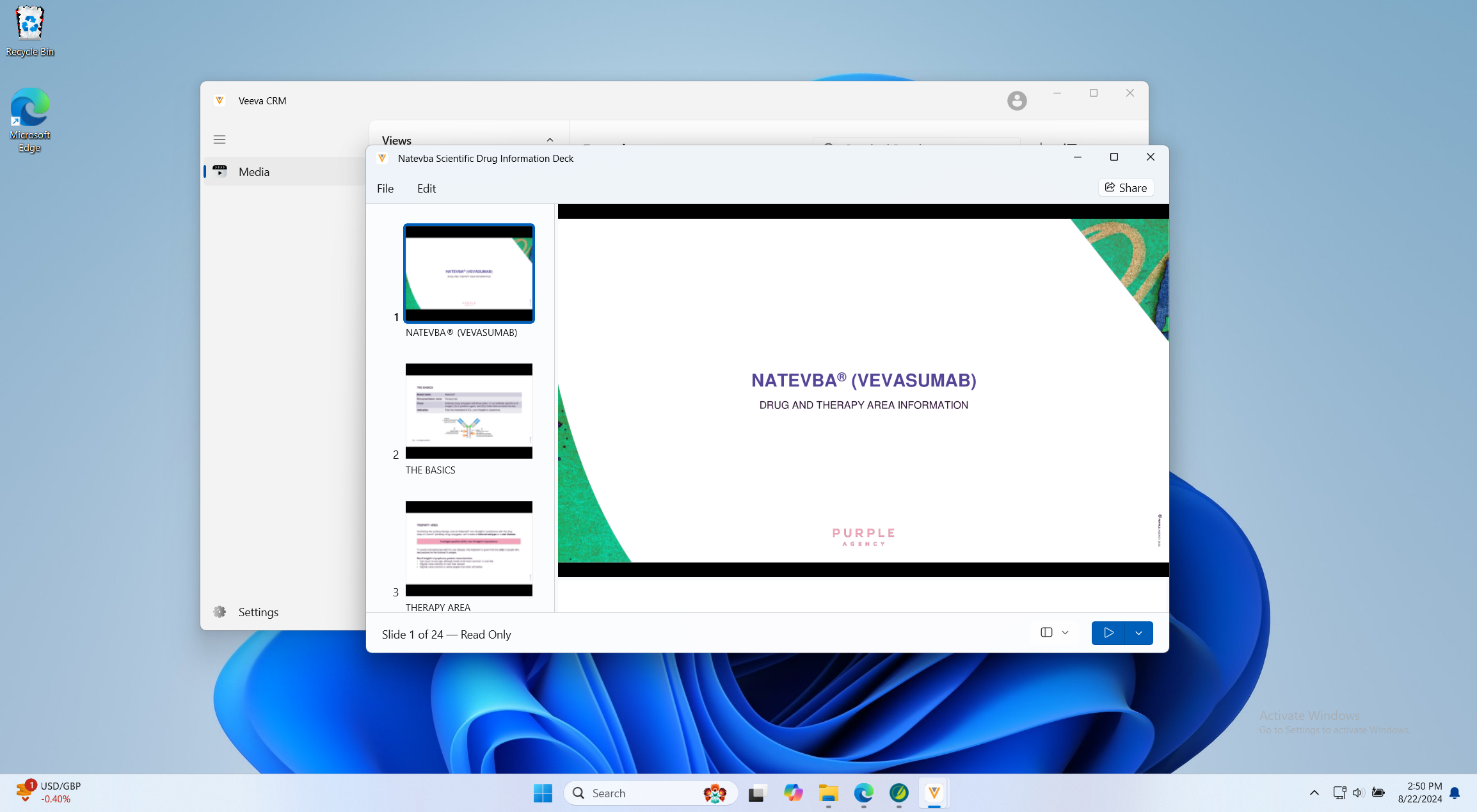
The preview displayed for each slide depends on the file type of the slide:
- Image – displays the image
- PDF – displays the PDF. Links are not active.
- Video – displays depending on the images available in the content package. Images are used in the follow order:
- Poster.png
- If Poster.png is not available, then display the fullscreen preview image (<filename>-full.png)
- If the fullscreen preview image is not available, then display thumb.png
See Packaging Custom CLM Content for more information.
- HTML – displays depending on the images available in the content package. Images are used in the follow order:
- Poster.png
- If Poster.png is not available, then display the fullscreen preview image (<filename>-full.png)
- If the fullscreen preview image is not available, then display the rendered HTML, including animations. However, the preview is not interactive and user input is ignored.
If a preview image cannot be rendered, the No Preview image displays.
A slide counter displays in the window. Sub-presentation slides are not counted in the total number of slides.
Displaying Presentations in Slide Show View
To display dynamic content and track key messages, users must display content in Slide Show View by selecting the Start Slideshow button in the bottom right corner of the Normal View window. In Slide Show View, slides display in fullscreen and are interactive.
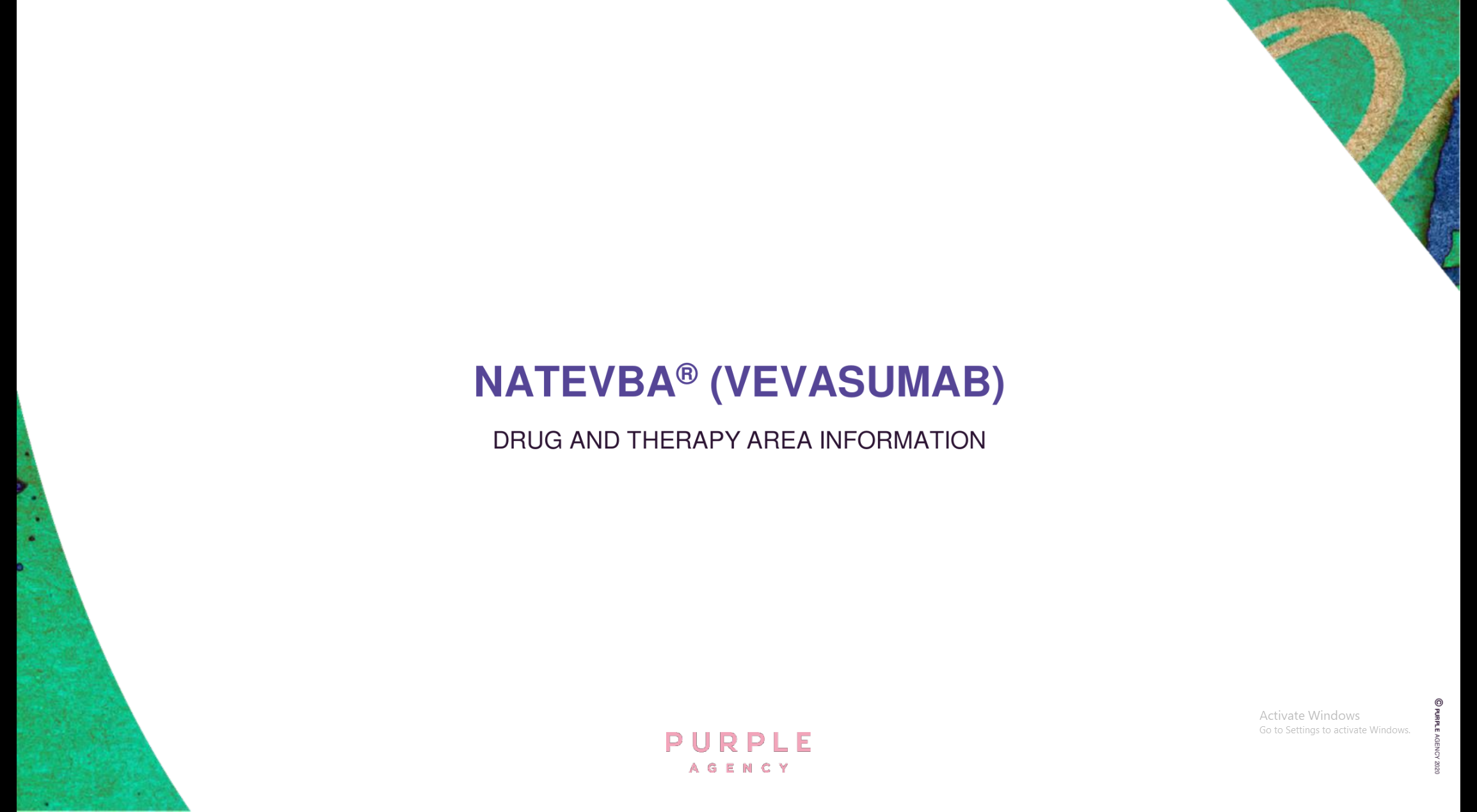
Displaying Presentations in Window View
Users can access other windows on their desktop while still presenting CLM content by switching to Window View so users can reference notes and other information during call mode. This allows easier navigation between windows without disrupting activity tracking.
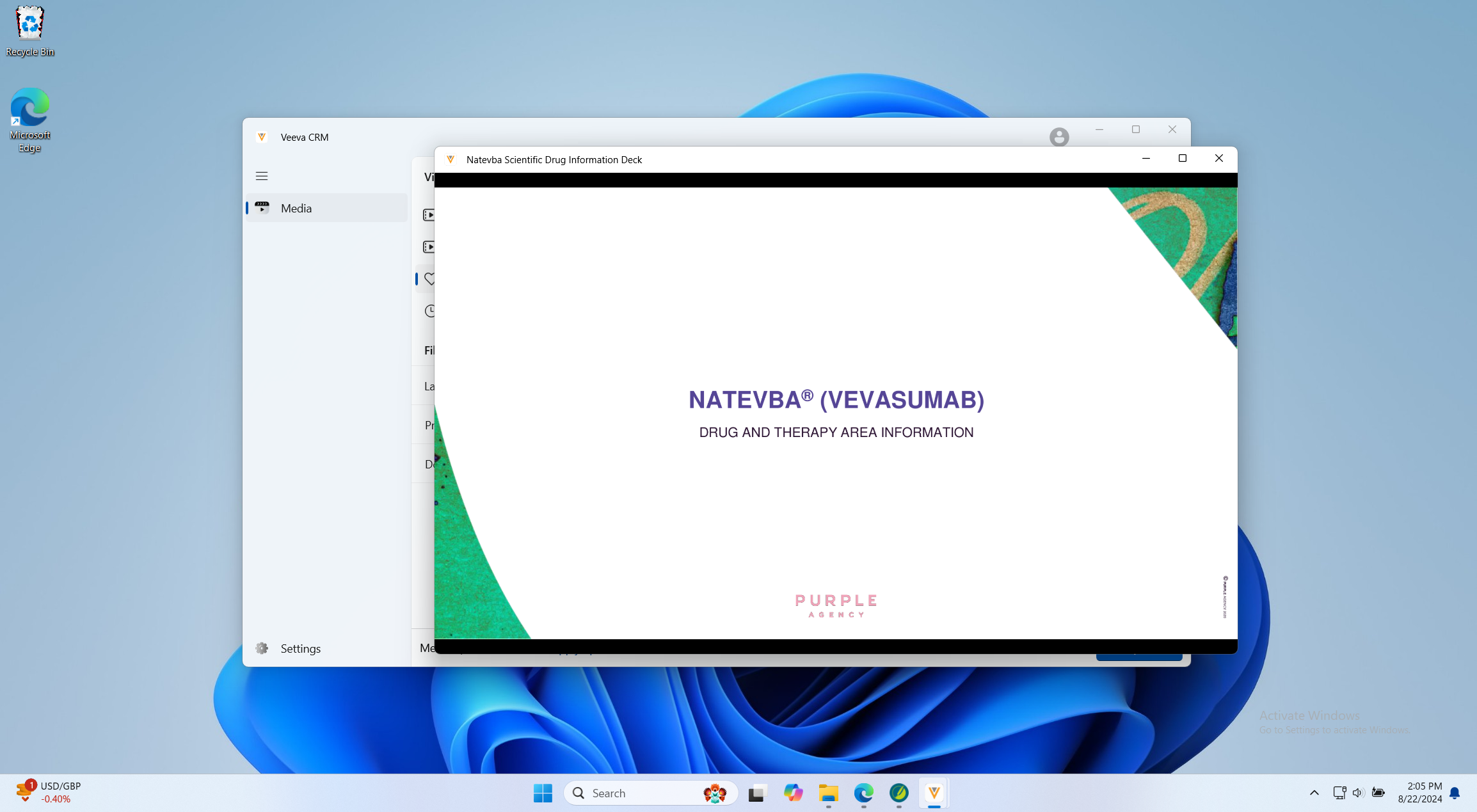
Users can move and resize the window while presenting.
When displaying content in Slide Show View, you can select Use Window View from the context menu to switch to Window View.
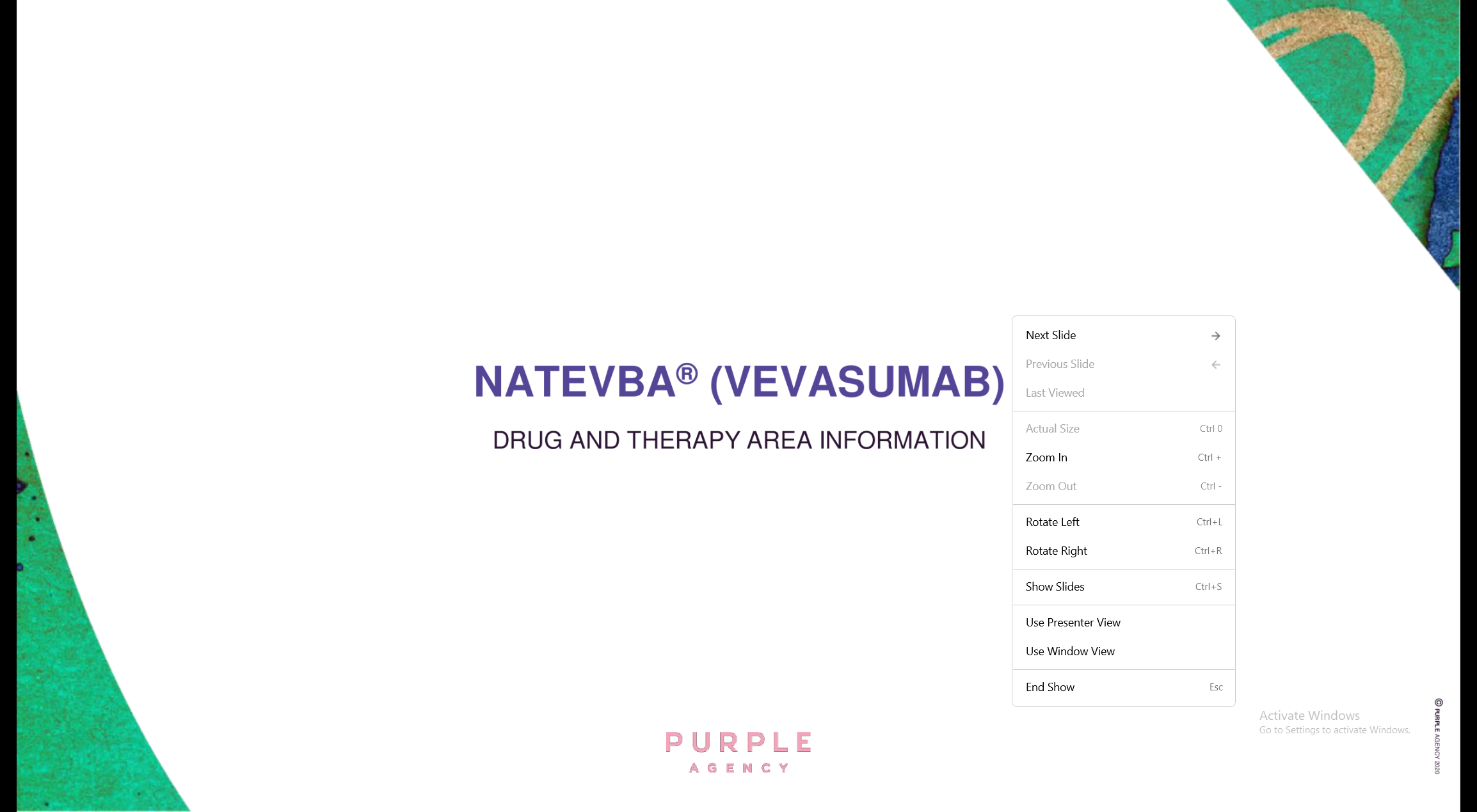
When displaying content in the Window View, select Use Slide Show View from the context menu to switch to Slide Show View.

To update the default window behavior when presenting content:
- Select Settings.

- Select the appropriate behavior in the Play Slide Show section. In Window is selected by default.
During Engage meetings, presentations in Normal View automatically display in Window View when shared, regardless of the default setting. When returning to Normal View, the sharing ends automatically.
Displaying Presentations in Presenter View
Users can display presentations in Presenter View, which includes the current slide and its slide notes, the navigation bar, and a preview of the next slide. Using Presenter View allows users to:
- Reference their notes for more context when presenting
- Prepare for the upcoming slide
- Easily navigate between slides in a presentation
- Check the amount of time spent presenting in the top left corner of the window to pace themselves if there is a time constraint
Granting Screen Recording Permission for CRM Desktop (Mac)
To display presentations in Presenter View on CRM Desktop (Mac), ebd users must grant screen recording permission to the Veeva CRM Desktop:
- Select the Apple menu > System Settings > Privacy & Security > Screen & System Audio Recording.
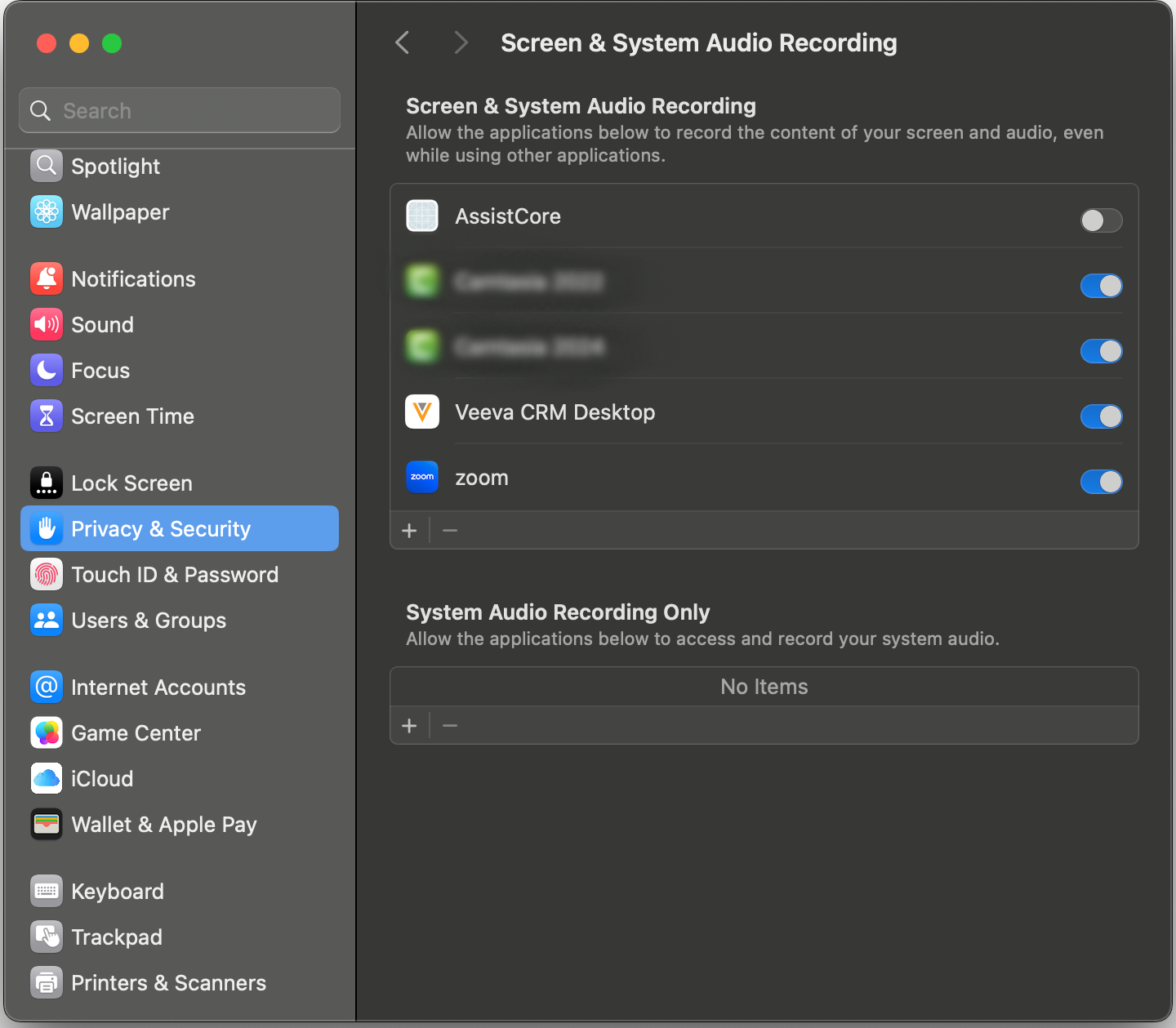
- Select the toggle for the Veeva CRM Desktop app. The toggle displays blue when enabled.
- Confirm the update using the appropriate authentication method.
Using Presenter View
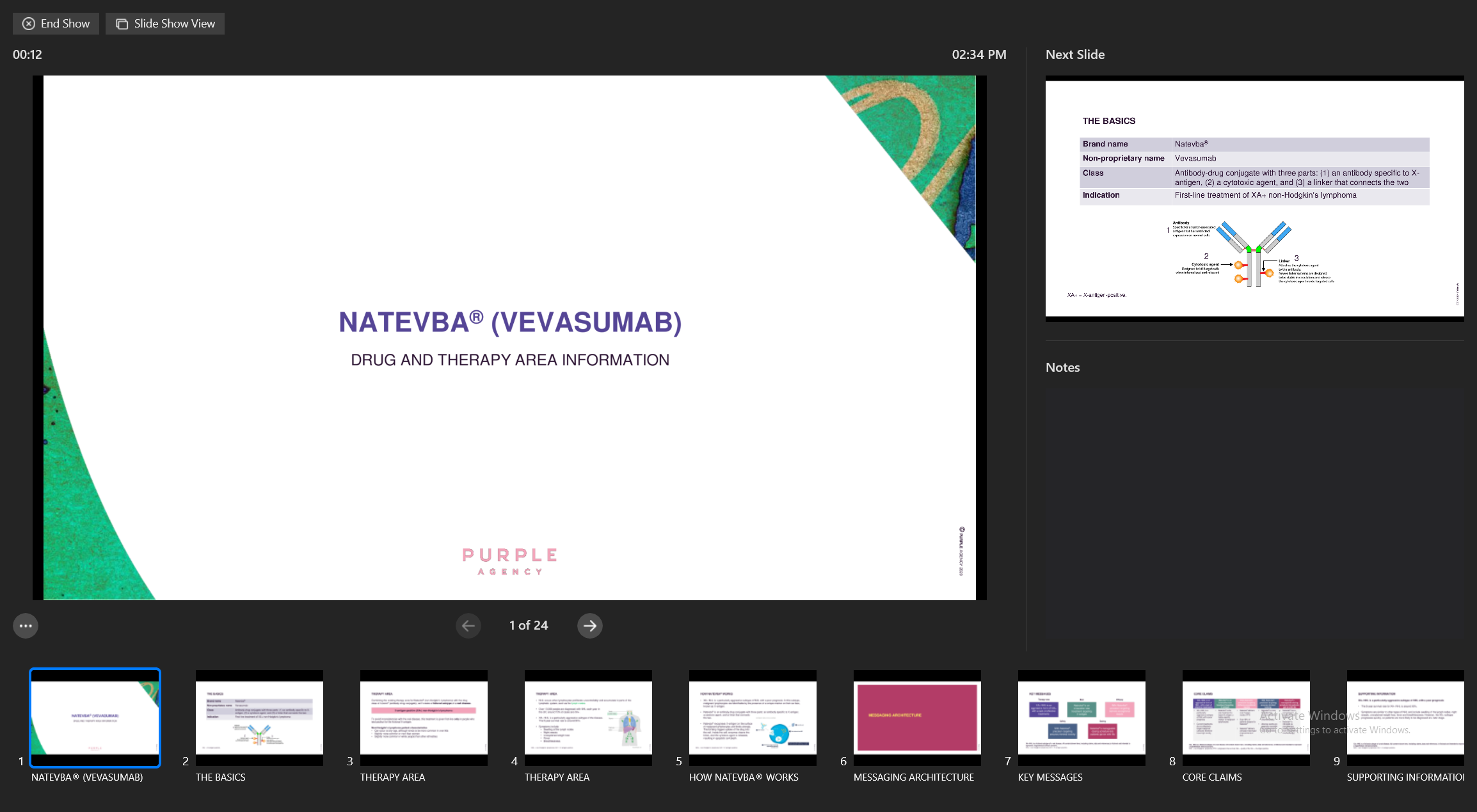
- Presenter View always displays in a fullscreen window and cannot be resized
- The fullscreen view of the current slide displays in a separate attendee window
- When sharing the content via Engage meeting, only the attendee window displays to attendees
- When sharing content using another remote meeting application, share the attendee window. Users can still navigate to and view the Presenter View window.
When using the Zoom app with one screen, users must set Screen capture mode to Secure share with window filtering in the Share Screen settings.
- Only one Presenter View window displays at a time. When displaying multiple presentations in Presenter View or switching between presentations using Alt + Tab (Windows) or Command + Tab/Command + ` (Mac), the Presenter View window updates to display information for the presentation in the foreground
- When using two screens, select Swap Displays to move the Presenter View window to the other monitor
- Slide rotation and hot keys are available in Presenter View
When using only one screen to share content from Veeva CRM Desktop via the Microsoft Teams Desktop app, Presenter View is not supported. Users can share content in Presenter View either via Microsoft Teams in the browser with only one screen or via the Microsoft Teams Desktop app with two or more screens.
To display a presentation in Presenter View:
- Select the Start Slideshow dropdown menu.
- Select Presenter View. When the user is not already in call mode, this starts preview mode or Save for Later call mode, if configured.
To interact with the presentation in Presenter View, select the displayed slide. The cursor displays orange to indicate you are interacting with the slide. The cursor returns to white when navigate away from the slide.
To transition from Slide Show View or Window View to Presenter View, select Use Presenter View from the More Actions menu or the right-select context menu.
To transition from Presenter View to Slide Show View, select Use Slide Show at the top of the window. Alternatively, select Use Slide Show View from the More Actions menu or the right-select context menu.
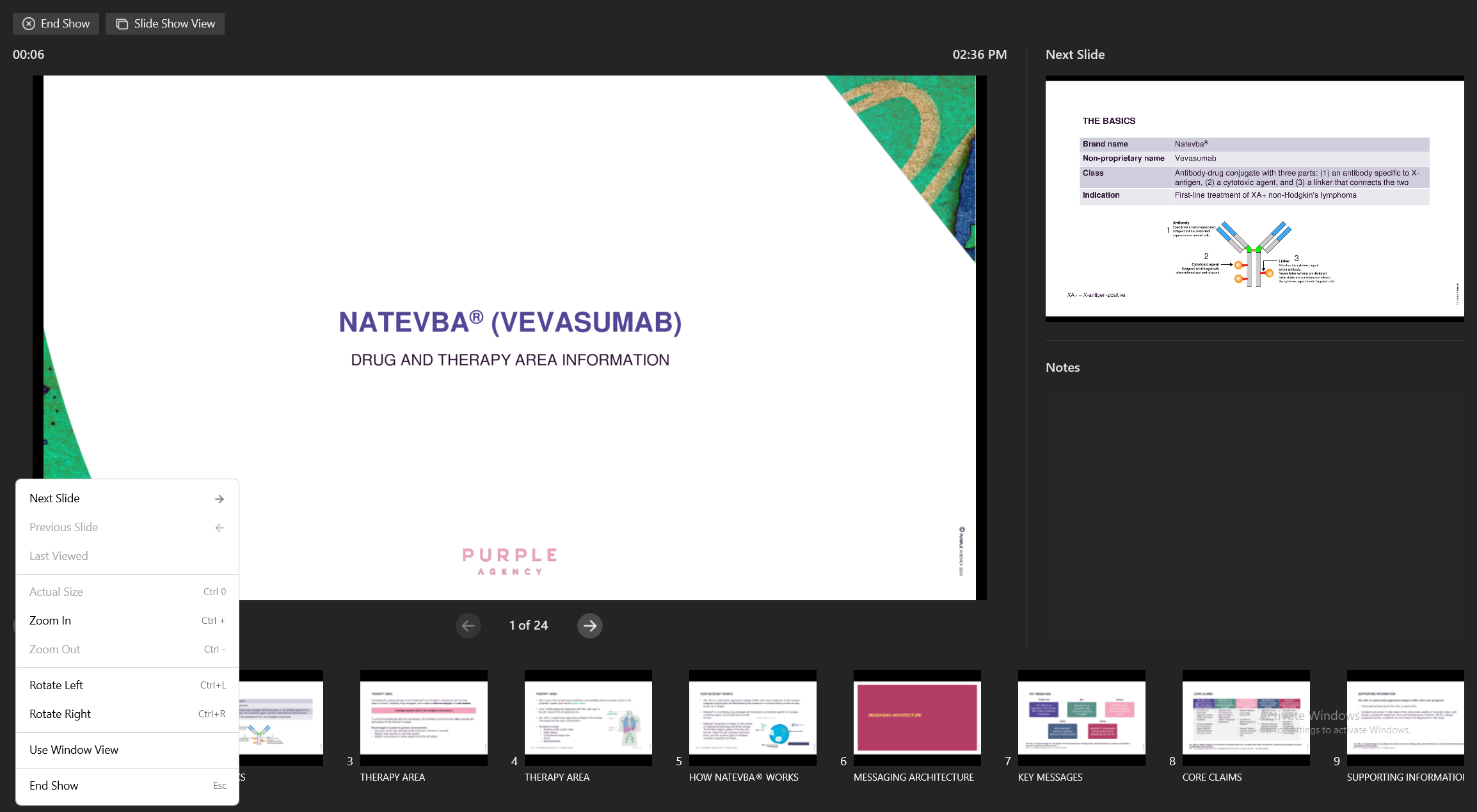
When users use the Present in Engage button to quickly share CLM content in an Engage meeting or when two monitors are available, CLM presentations display in Presenter View by default. To disable this:
- Select Settings.
- Deselect the Always Start Presenter View check box.

Using Sub-Presentations in Presenter View
In the navigation bar, the thumbnail for a sub-presentation displays as a stack of slides with the label Required. Thumbnails for the main presentation slides associated with the sub-presentation are grayed out until the user finishes displaying all the slides in the sub-presentation.
Select the sub-presentation thumbnail to view all the slides in the sub-presentation. Each slide in the sub-presentation is grayed out until the preceding slide displays for at least two seconds, to ensure users display the slides in order. After all the slides in a sub-presentation display, the thumbnail in the navigation bar becomes grayed out and does not display the Required label. However, users can still select the grayed out thumbnail and navigate to the sub-presentation.
Opening Multiple Presentation Windows
Users can open multiple presentation windows at once. Launch each presentation one by one or use the following options to select multiple presentations and launch them all at once:
- Selecting the Open button in the media library
- Using the appropriate keyboard shortcut (Enter on Windows, Command + O on Mac)
- Selecting Open from the right-select context menu
Users can also use the context menu to perform the following actions to multiple selected presentations:
- Download
- Favorite
- Add Labels
- Duplicate
- Delete

Sync updates to the media library can be applied while presentations are open. Open presentations are not updated until the user selects Apply Updates in the media library. When the user applies the update, open presentations become black screens in the following cases:
- The presentation is expired and no longer available in the media library
- Mac: There is an updated version of the presentation. The user must download the updated version of the presentation in the media library and refresh the presentation window to display the updated content.
- Windows: There is an updated version of the presentation and the user downloads the updated version of the presentation in the media library. The user must refresh the presentation window to display the updated content.
During call mode, multiple presentations can be open and tracked on the call, but only one presentation can be tracked at a time. Tracking is paused for presentations in Slide Show View, Window View, or Presenter View which are not displayed in the foreground. The app creates a Call2_Key_Message_vod record for each presentation shared in the foreground that meets the tracking criteria. See Tracking CLM Key Messages for more information on the tracking criteria.
During call mode, open presentations which are not available for the call display black screens. CLM presentations available for a call are based on the Restricted Products, Allowed Products, and Account Segmentations for the accounts in the call.
Tracking CLM Activity in Call Mode
In call mode, displaying a presentation in Slide Show View, Window View, or Presenter View tracks the key messages on the call report. For Slide Show View and Window View, sub-presentations can only be displayed once per call mode session. If the user ends and then restarts call mode, the sub-presentations can be displayed again.
When users display CLM presentations in Slide Show View, Window View, or Presenter View without initiating call mode, the CLM activity is tracked on Multichannel_Activity_vod and Multichannel_Activity_Line_vod records and is not associated with a call. See Tracking CLM Preview Activity on Veeva CRM on Desktop for more information. To enable Save for Later tracking, which replaces tracking unassociated CLM activity, see Tracking Save for Later CLM Activity in Veeva CRM on Desktop.
On the CRM Desktop (Mac) platform, displaying a presentation in Slide Show View creates a space. Users can swipe to navigate between spaces. See the Apple documentation for more information about spaces.
Navigating Between Presentation Slides
Use the keyboard arrow keys to navigate between slides. Use the Escape key to exit a presentation. Users cannot navigate backwards in a sub-presentation. When users finish displaying a sub-presentation, use the right arrow key to display the parent slide. Exiting Slide Show View, Window View, or Presenter View displays Normal View and the thumbnail for the most recently displayed slide is selected.
Users can also navigate a presentation using the shortcut menu. The shortcut menu includes the Last Viewed option, which allows users to navigate to the 10 most recently displayed slides, including sub-presentation slides. Last Viewed is unavailable if there are no previously displayed slides.
Users can rotate slides to display in landscape orientation using the following methods:
- The Rotate Left and Rotate Right buttons in the action menu
- The hot keys for the appropriate platform
- Rotate left: Ctrl + L on Windows, Cmd + L on Mac
- Rotate right: Ctrl + R on Windows, Cmd + R on Mac
Users can zoom in and out of image, PDF, and HTML content to easily view small text or diagrams. The content must be published as a Multi Slide Presentation from Vault. The following methods are available:
- Using hot keys
- Zoom in: Ctrl + on Windows, Cmd + on Mac
- Zoom out: Ctrl - on Windows, Cmd - on Mac
- Return to original size: Ctrl 0 on Windows, Cmd 0 on Mac
- Using the right-select context menu
- Double selecting the content. This is only available for image content and is not supported for HTML or PDF content.
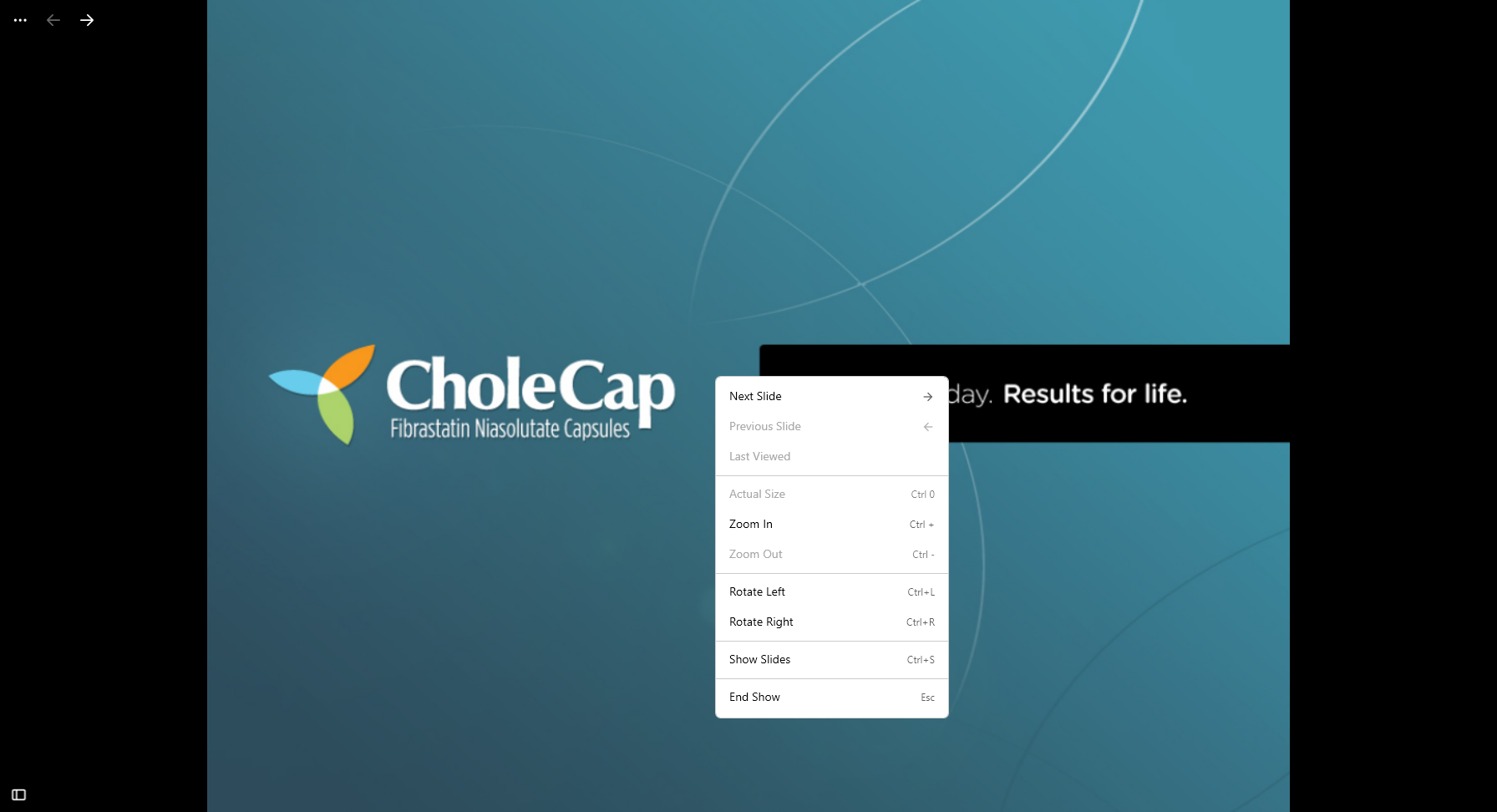
Admins can also disable zoom for specific key messages for compliance reasons. See Disabling Touch Gestures in CRM for more information.



